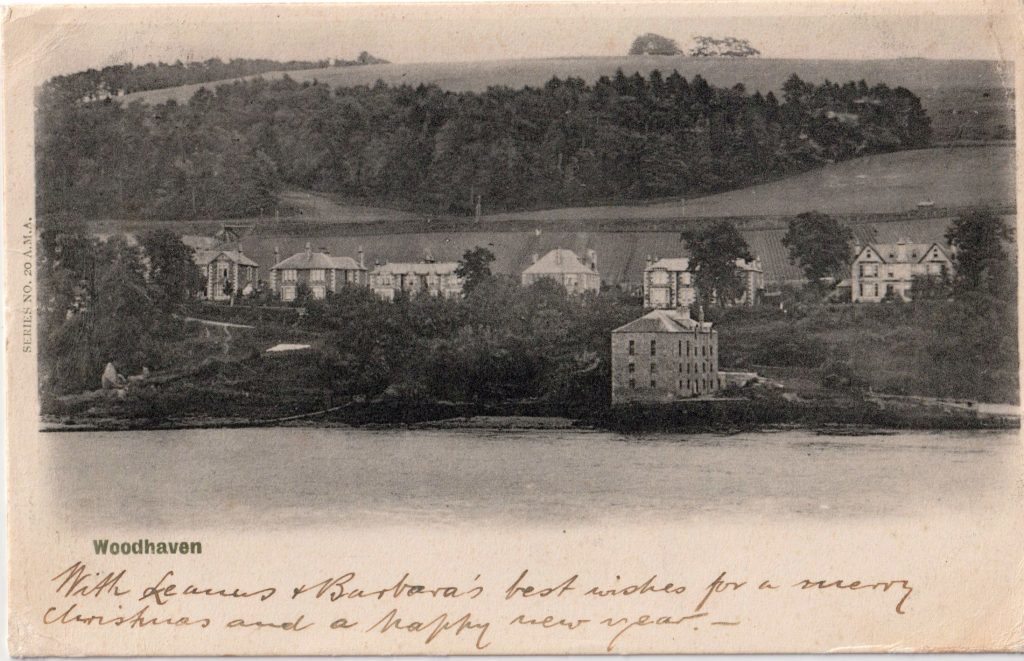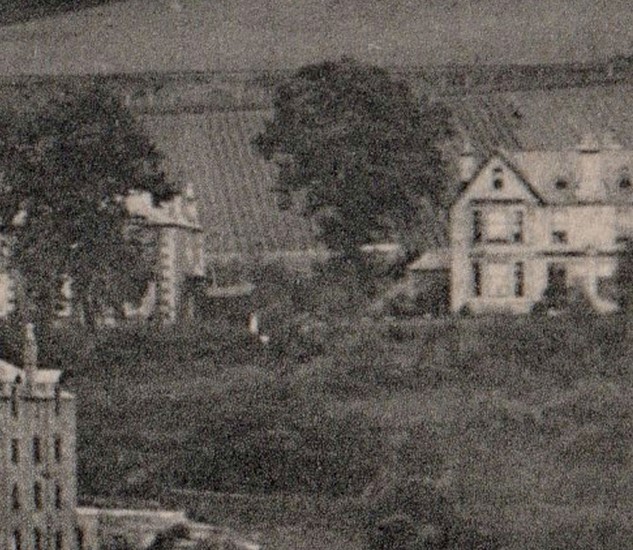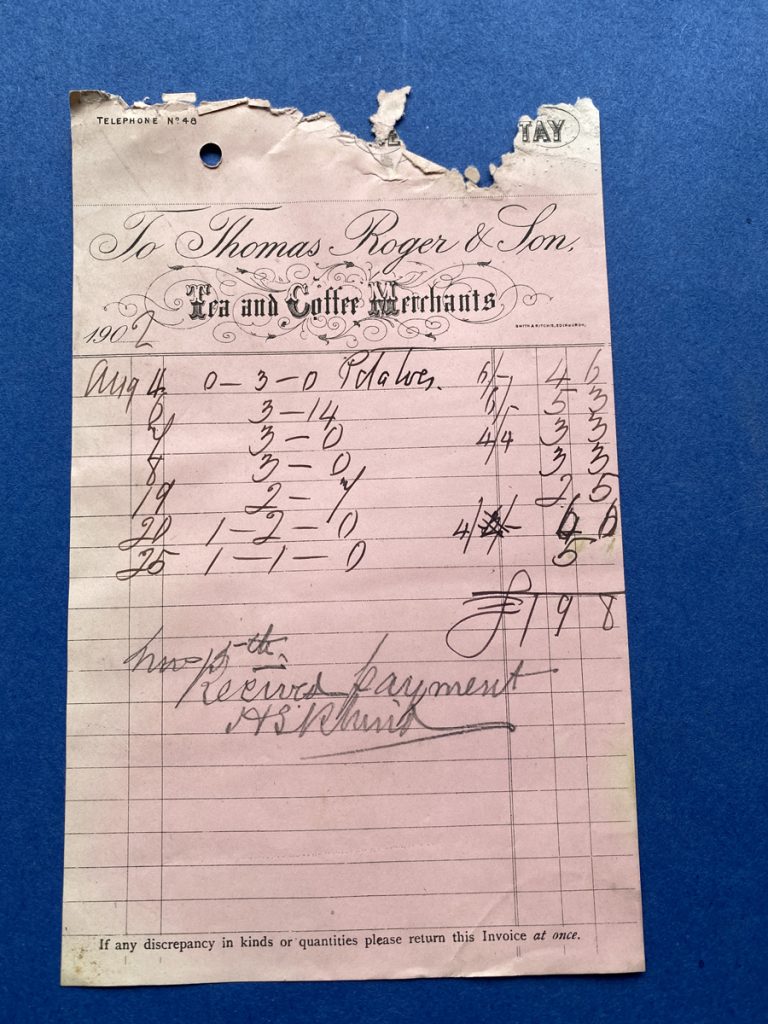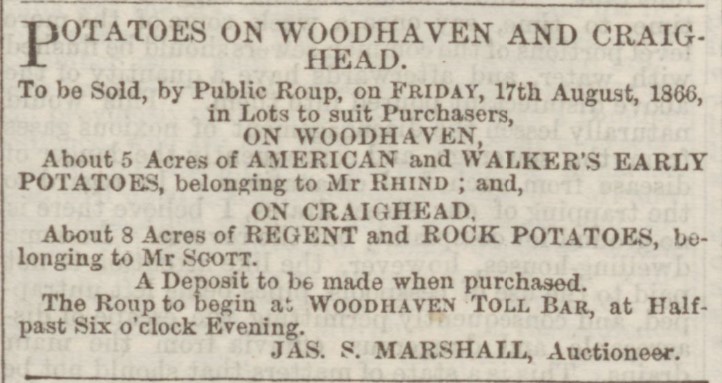Potatoes – where do you get yours from? Some of us can grow our own; or we could go to the local farm shop (if we are lucky), visit the greengrocer’s (even thinner on the ground), or make do with the supermarket. Over the years, dealing in this staple food has taken a number of forms.
Knowing your food’s provenance and having a minimum of food-miles are nothing new. A good local source was ideal – and Woodhaven Farm grew good potatoes.

Part of Woodhaven Farm – is that potatoes in the field behind the houses?

Buying and selling potatoes
So, in Edwardian Newport you would have sent your maid to one of the many local shops for supplies, as well as to catch up on the local gossip.
Thomas Roger’s grocer’s shop in Newport High Street was supplied direct by Henry Rhind, the Woodhaven farmer and son of Alexander Rhind the baker.

The wholesale background
By way of explanation for those of you not totally up to speed with the finer points of pre-decimal commerce :
- The invoice is for potatoes supplied by H S Rhind to Thomas Roger, Newport 1
- The potatoes are supplied in quantities of hundredweights, quarters and pounds : 28 pounds = 1 quarter, 4 quarters = 1 hundredweight, 20 hundredweight = 1 ton; (roughly speaking, 1 pound is a little less than 500 grams, 1 quarter is over 12 kg, and 1 hundredweight is about 50 kg). (You could also buy a quarter of sweeties – but that was a different quarter!)
- The unit price of the potatoes is per hundredweight
- The unit price goes down during the month from 6/- (6 shillings) to 4/- (from 30p to 20p for 50kg)
- The prices are wholesale ones, we don’t know Roger’s retail prices
- The potatoes were supplied in August, the bill was paid in November
- Selling to local shops brought in more profit to the farmer than selling in bulk, as long as they were good quality (both the potatoes and the shops!)
Thus the August 4th delivery was 0 hundredweight – 3 quarters – 0 pounds at 6/- per hundredweight = 4/6d
Totals for the month : 6 hundredweight – 1 quarter – 21 pounds of potatoes supplied for £1-9-8 (327.23 kg for £1.48 – that’s 2.2kg for 1p)
Back in Victorian Times
The more common ways to sell your potatoes were by auction or sending them to market. Before the creation of Newport High Street, the Woodhaven farmer sold his whole growing crop by public roup, divided into whatever size lots the purchasers required. This advert is from the Dundee Courier 14 August 1866 2:

A similar advert in 1876 offered the crop delivered to Newport or put on board the Dundee ferry.3

Grow Your Own Veg, Georgian-style
But in Georgian times, the potato business was done rather differently.
In July 1825 Woodhaven Farm was managing a mix of animals and crops. The crops were mostly cereals but there was one field of turnips and one of potatoes. You would have expected the potatoes to be sold off when ready, but – no – at that time the rows were let out as they were growing.
David Brown was the tenant farmer and innkeeper at Woodhaven when he died in May 1825. All the goods he owned, including the animals and crops, are listed in the inventory taken after his death.4 On the farm there were about 6 acres of growing potatoes valued at £60, and there is a list of the people who had paid for them. The drills were let out at a cost of 1/1½d per lineal fall (1 shilling 1½d per 18 feet 6 inches, or 6p. per 5.6m in decimal terms). This part of the inventory is :
| Potatoes from East 22 drills Mrs Brown’s own |
| and let to the following persons at 1/1½ per fall lineal measure viz: |
| 2 drills William Raitt |
| 3 drills David Sandeman |
| 3 drills David Gibb |
| 2 drills Alexander Mill |
| 4 drills Robert Mackie |
| 1 drill John Elder |
| 2 drills Alexander Allan |
| 2 drills James Hutton |
| 4 drills Henry Moyes |
| 2 drills Margaret Meldrum |
| 1 drill Andrew Brown |
| 1 drill Robert Foreman |
| 4 drills William Patrick |
| 1 drill James Martin |
| 1 drill John Kidd |
| 3 drills Arthur Band |
| 4 drills Andrew Kilgour |
| 1 drill Oliver Mathieson |
| 4 drills David Just |
| 3 drills Donald Cruickshanks |
| 4 drills James Johnstone |
| 1 drill Janet Henderson |
| 3 drills George Greig |
| 1 drill Thomas Henderson |
| 2 drills Andrew Kilgour jun |
| 3 drills Thomas Ritchie |
| 1 drill Ann Lowrie |
| 1 drill David Brand |
| 2 drills Alex Tosh |
| 3 drills George Fotheringham |
| 1 drill Mrs Ferrier |
| 1 drill Thomas Welsh |
| 2 drills George Honeyman |
| 1 drill Susan Brown |
| 1 drill Margaret Mitchell |
| 2 drills Mr Waghton |
| 1 drill George Brown |
| 2 drills Elisabeth Crichton |
| 2 drills Ann Peattie |
| 1 drill James Duncan |
| 2 drills Henry Baxter |
| 2 drills Robert Williamson |
| 2 drills James Mackie |
| 3 drills James Meffan |
| Remainder Mrs Brown’s own |
| In all about 6 acres |
- That is 92 drills for customers, and 22 + the ‘remainder’ for Mrs Brown herself.
- Many of those named here lived in Woodhaven and some lived in Newport.5 Some of them may have been farm labourers being paid potatoes in kind (although the more I think about it, these would be included in ‘Mrs Brown’s own’ for the business).
- The drills are listed in order counting from the east, so you couldn’t help yourself to potatoes from someone else’s drill.
- We don’t know how long the drills were and consquently don’t know how much each person paid.
Grow your own, certainly – but did you pick your own too?
Woodhaven’s Georgian residents knew a good thing when they tasted it.
Sources:
- Invoice to Thomas Roger, 1903
- Dundee Courier, 14 Aug 1866, p4 (all newspapers available at British Newspaper Archive)
- Dundee Courier, 25 Aug 1876, p1
- Wills and Testaments, SC20/50/2, David Brown 1826, original at ScotlandsPeople
- Baptism registers, Forgan parish
Postcard: personal collection
